Analysis of Ford Company: Decision Making, VRIO, and Managerial Skills
VerifiedAdded on 2023/06/07
|14
|2883
|72
Report
AI Summary
This report provides a comprehensive analysis of the Ford Motor Company, focusing on its decision-making processes, the application of the VRIO (Value, Rare, Imitability, and Organization) framework, and the significance of managerial skills. The report begins by outlining the steps involved in the decision-making process within an organization, emphasizing the importance of identifying problems, gathering information, identifying alternatives, weighing evidence, choosing alternatives, implementing actions, and evaluating results. It then delves into the VRIO framework, explaining how it helps organizations assess their resources and capabilities to achieve a competitive advantage. The report analyzes Ford's resources and capabilities through the VRIO lens, highlighting its strong brand, corporate culture, distribution network, and marketing strategies. Furthermore, it discusses the importance of various managerial skills, such as creativity, responsibility, and self-confidence, in ensuring the smooth operation and success of an organization. The report concludes with recommendations based on the analysis, emphasizing the crucial role of effective decision-making, resource management, and managerial skills in achieving Ford's strategic objectives and maintaining its competitive edge in the automotive industry.
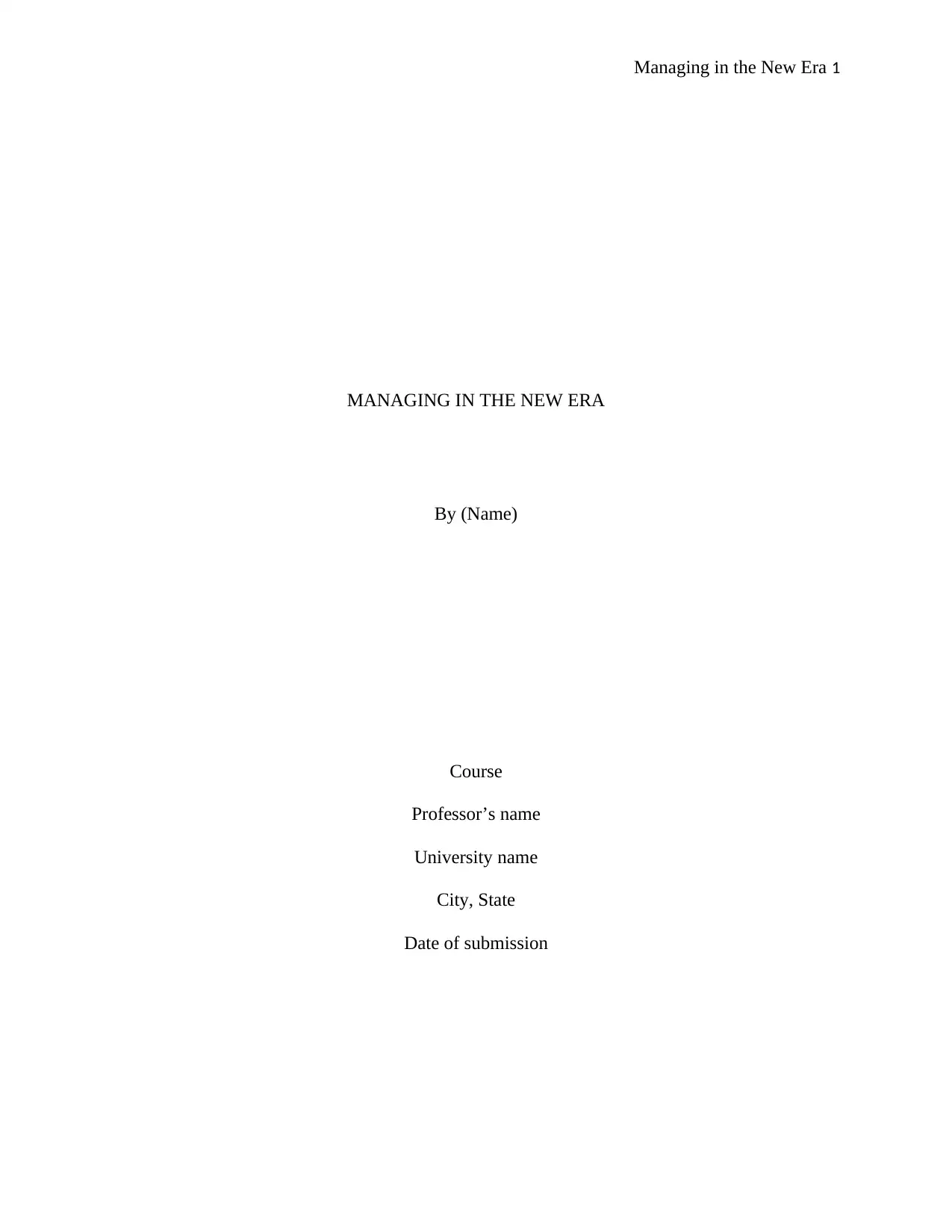
Managing in the New Era 1
MANAGING IN THE NEW ERA
By (Name)
Course
Professor’s name
University name
City, State
Date of submission
MANAGING IN THE NEW ERA
By (Name)
Course
Professor’s name
University name
City, State
Date of submission
Paraphrase This Document
Need a fresh take? Get an instant paraphrase of this document with our AI Paraphraser
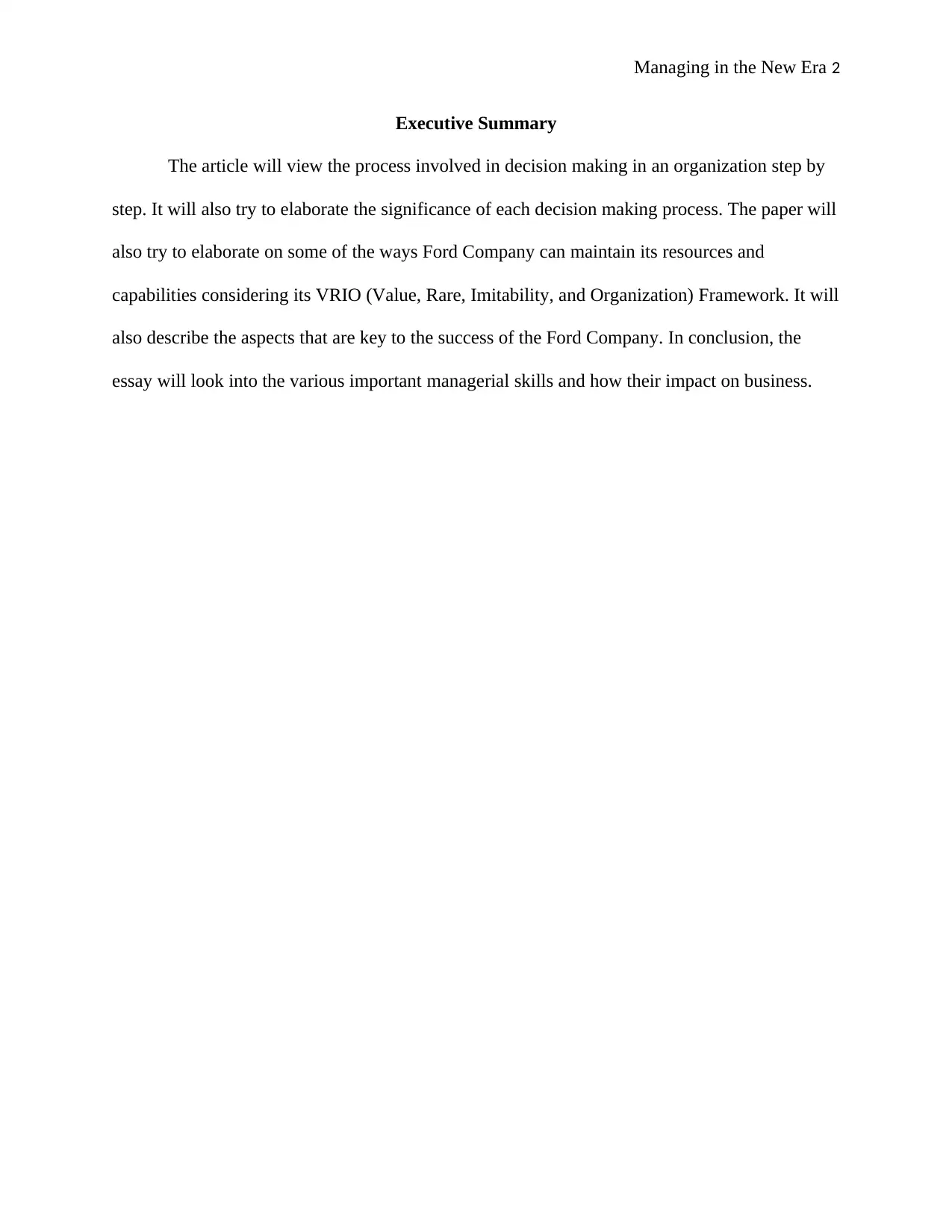
Managing in the New Era 2
Executive Summary
The article will view the process involved in decision making in an organization step by
step. It will also try to elaborate the significance of each decision making process. The paper will
also try to elaborate on some of the ways Ford Company can maintain its resources and
capabilities considering its VRIO (Value, Rare, Imitability, and Organization) Framework. It will
also describe the aspects that are key to the success of the Ford Company. In conclusion, the
essay will look into the various important managerial skills and how their impact on business.
Executive Summary
The article will view the process involved in decision making in an organization step by
step. It will also try to elaborate the significance of each decision making process. The paper will
also try to elaborate on some of the ways Ford Company can maintain its resources and
capabilities considering its VRIO (Value, Rare, Imitability, and Organization) Framework. It will
also describe the aspects that are key to the success of the Ford Company. In conclusion, the
essay will look into the various important managerial skills and how their impact on business.
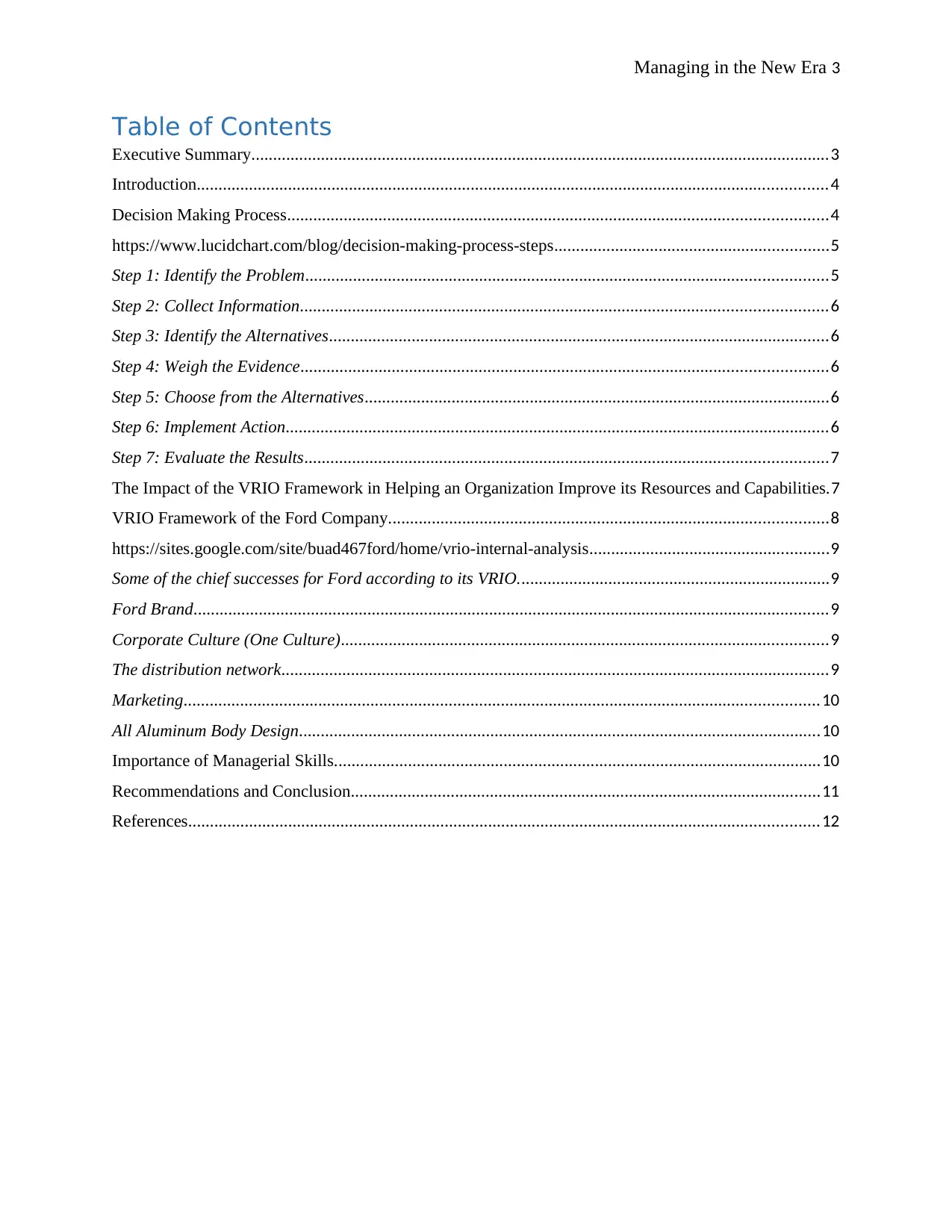
Managing in the New Era 3
Table of Contents
Executive Summary.....................................................................................................................................3
Introduction.................................................................................................................................................4
Decision Making Process............................................................................................................................4
https://www.lucidchart.com/blog/decision-making-process-steps...............................................................5
Step 1: Identify the Problem........................................................................................................................5
Step 2: Collect Information.........................................................................................................................6
Step 3: Identify the Alternatives...................................................................................................................6
Step 4: Weigh the Evidence.........................................................................................................................6
Step 5: Choose from the Alternatives...........................................................................................................6
Step 6: Implement Action.............................................................................................................................6
Step 7: Evaluate the Results........................................................................................................................7
The Impact of the VRIO Framework in Helping an Organization Improve its Resources and Capabilities.7
VRIO Framework of the Ford Company.....................................................................................................8
https://sites.google.com/site/buad467ford/home/vrio-internal-analysis.......................................................9
Some of the chief successes for Ford according to its VRIO........................................................................9
Ford Brand..................................................................................................................................................9
Corporate Culture (One Culture)................................................................................................................9
The distribution network..............................................................................................................................9
Marketing..................................................................................................................................................10
All Aluminum Body Design........................................................................................................................10
Importance of Managerial Skills................................................................................................................10
Recommendations and Conclusion............................................................................................................11
References.................................................................................................................................................12
Table of Contents
Executive Summary.....................................................................................................................................3
Introduction.................................................................................................................................................4
Decision Making Process............................................................................................................................4
https://www.lucidchart.com/blog/decision-making-process-steps...............................................................5
Step 1: Identify the Problem........................................................................................................................5
Step 2: Collect Information.........................................................................................................................6
Step 3: Identify the Alternatives...................................................................................................................6
Step 4: Weigh the Evidence.........................................................................................................................6
Step 5: Choose from the Alternatives...........................................................................................................6
Step 6: Implement Action.............................................................................................................................6
Step 7: Evaluate the Results........................................................................................................................7
The Impact of the VRIO Framework in Helping an Organization Improve its Resources and Capabilities.7
VRIO Framework of the Ford Company.....................................................................................................8
https://sites.google.com/site/buad467ford/home/vrio-internal-analysis.......................................................9
Some of the chief successes for Ford according to its VRIO........................................................................9
Ford Brand..................................................................................................................................................9
Corporate Culture (One Culture)................................................................................................................9
The distribution network..............................................................................................................................9
Marketing..................................................................................................................................................10
All Aluminum Body Design........................................................................................................................10
Importance of Managerial Skills................................................................................................................10
Recommendations and Conclusion............................................................................................................11
References.................................................................................................................................................12
⊘ This is a preview!⊘
Do you want full access?
Subscribe today to unlock all pages.

Trusted by 1+ million students worldwide
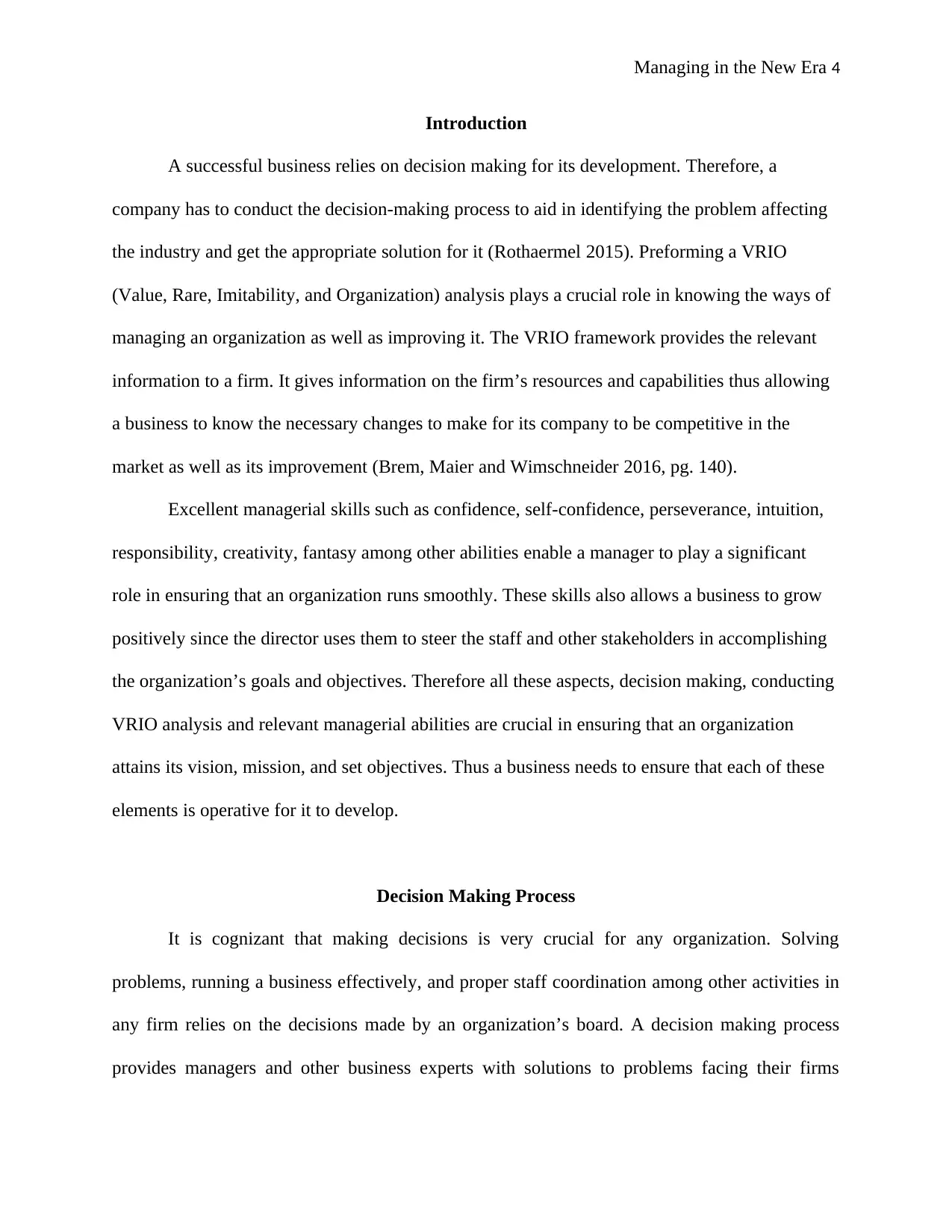
Managing in the New Era 4
Introduction
A successful business relies on decision making for its development. Therefore, a
company has to conduct the decision-making process to aid in identifying the problem affecting
the industry and get the appropriate solution for it (Rothaermel 2015). Preforming a VRIO
(Value, Rare, Imitability, and Organization) analysis plays a crucial role in knowing the ways of
managing an organization as well as improving it. The VRIO framework provides the relevant
information to a firm. It gives information on the firm’s resources and capabilities thus allowing
a business to know the necessary changes to make for its company to be competitive in the
market as well as its improvement (Brem, Maier and Wimschneider 2016, pg. 140).
Excellent managerial skills such as confidence, self-confidence, perseverance, intuition,
responsibility, creativity, fantasy among other abilities enable a manager to play a significant
role in ensuring that an organization runs smoothly. These skills also allows a business to grow
positively since the director uses them to steer the staff and other stakeholders in accomplishing
the organization’s goals and objectives. Therefore all these aspects, decision making, conducting
VRIO analysis and relevant managerial abilities are crucial in ensuring that an organization
attains its vision, mission, and set objectives. Thus a business needs to ensure that each of these
elements is operative for it to develop.
Decision Making Process
It is cognizant that making decisions is very crucial for any organization. Solving
problems, running a business effectively, and proper staff coordination among other activities in
any firm relies on the decisions made by an organization’s board. A decision making process
provides managers and other business experts with solutions to problems facing their firms
Introduction
A successful business relies on decision making for its development. Therefore, a
company has to conduct the decision-making process to aid in identifying the problem affecting
the industry and get the appropriate solution for it (Rothaermel 2015). Preforming a VRIO
(Value, Rare, Imitability, and Organization) analysis plays a crucial role in knowing the ways of
managing an organization as well as improving it. The VRIO framework provides the relevant
information to a firm. It gives information on the firm’s resources and capabilities thus allowing
a business to know the necessary changes to make for its company to be competitive in the
market as well as its improvement (Brem, Maier and Wimschneider 2016, pg. 140).
Excellent managerial skills such as confidence, self-confidence, perseverance, intuition,
responsibility, creativity, fantasy among other abilities enable a manager to play a significant
role in ensuring that an organization runs smoothly. These skills also allows a business to grow
positively since the director uses them to steer the staff and other stakeholders in accomplishing
the organization’s goals and objectives. Therefore all these aspects, decision making, conducting
VRIO analysis and relevant managerial abilities are crucial in ensuring that an organization
attains its vision, mission, and set objectives. Thus a business needs to ensure that each of these
elements is operative for it to develop.
Decision Making Process
It is cognizant that making decisions is very crucial for any organization. Solving
problems, running a business effectively, and proper staff coordination among other activities in
any firm relies on the decisions made by an organization’s board. A decision making process
provides managers and other business experts with solutions to problems facing their firms
Paraphrase This Document
Need a fresh take? Get an instant paraphrase of this document with our AI Paraphraser
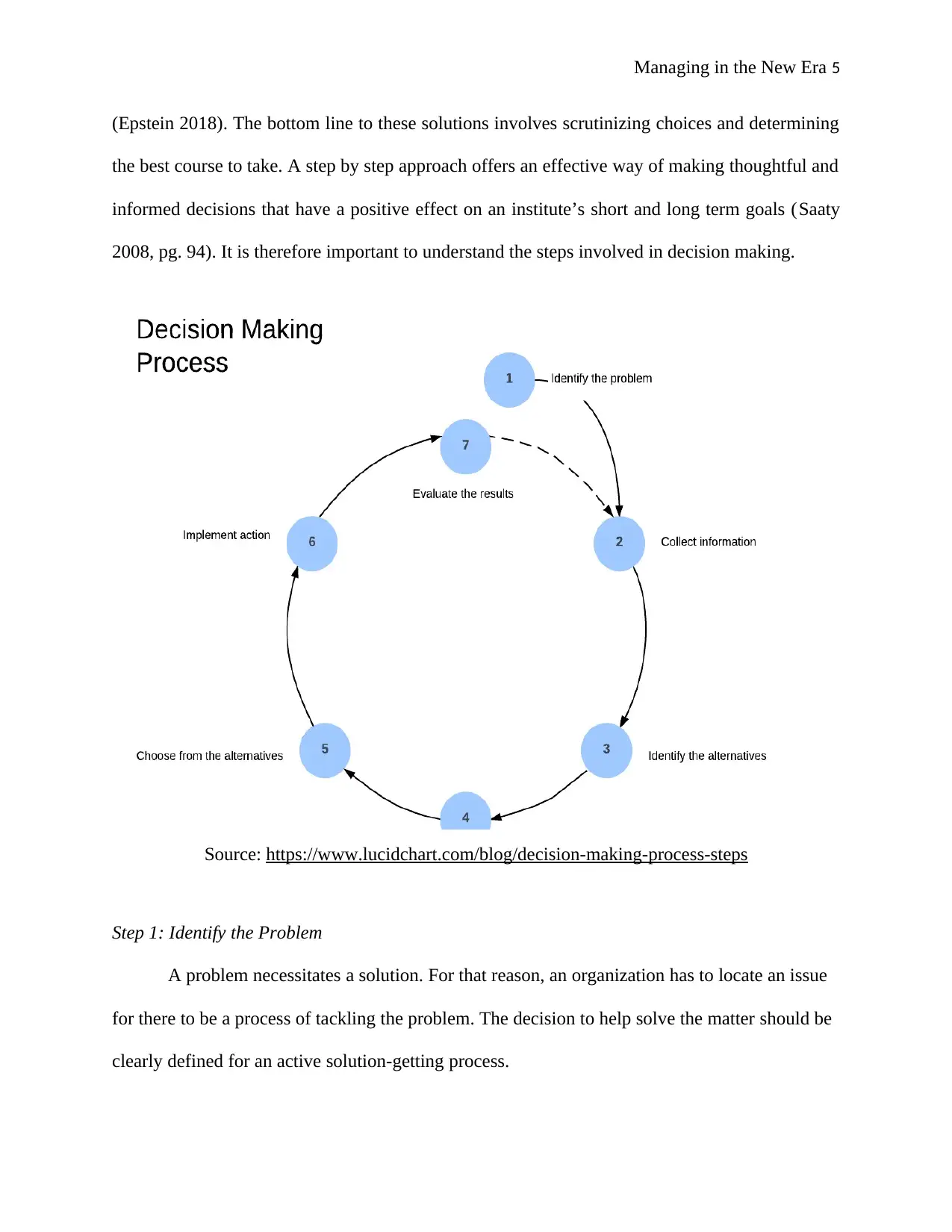
Managing in the New Era 5
(Epstein 2018). The bottom line to these solutions involves scrutinizing choices and determining
the best course to take. A step by step approach offers an effective way of making thoughtful and
informed decisions that have a positive effect on an institute’s short and long term goals (Saaty
2008, pg. 94). It is therefore important to understand the steps involved in decision making.
Source: https://www.lucidchart.com/blog/decision-making-process-steps
Step 1: Identify the Problem
A problem necessitates a solution. For that reason, an organization has to locate an issue
for there to be a process of tackling the problem. The decision to help solve the matter should be
clearly defined for an active solution-getting process.
(Epstein 2018). The bottom line to these solutions involves scrutinizing choices and determining
the best course to take. A step by step approach offers an effective way of making thoughtful and
informed decisions that have a positive effect on an institute’s short and long term goals (Saaty
2008, pg. 94). It is therefore important to understand the steps involved in decision making.
Source: https://www.lucidchart.com/blog/decision-making-process-steps
Step 1: Identify the Problem
A problem necessitates a solution. For that reason, an organization has to locate an issue
for there to be a process of tackling the problem. The decision to help solve the matter should be
clearly defined for an active solution-getting process.
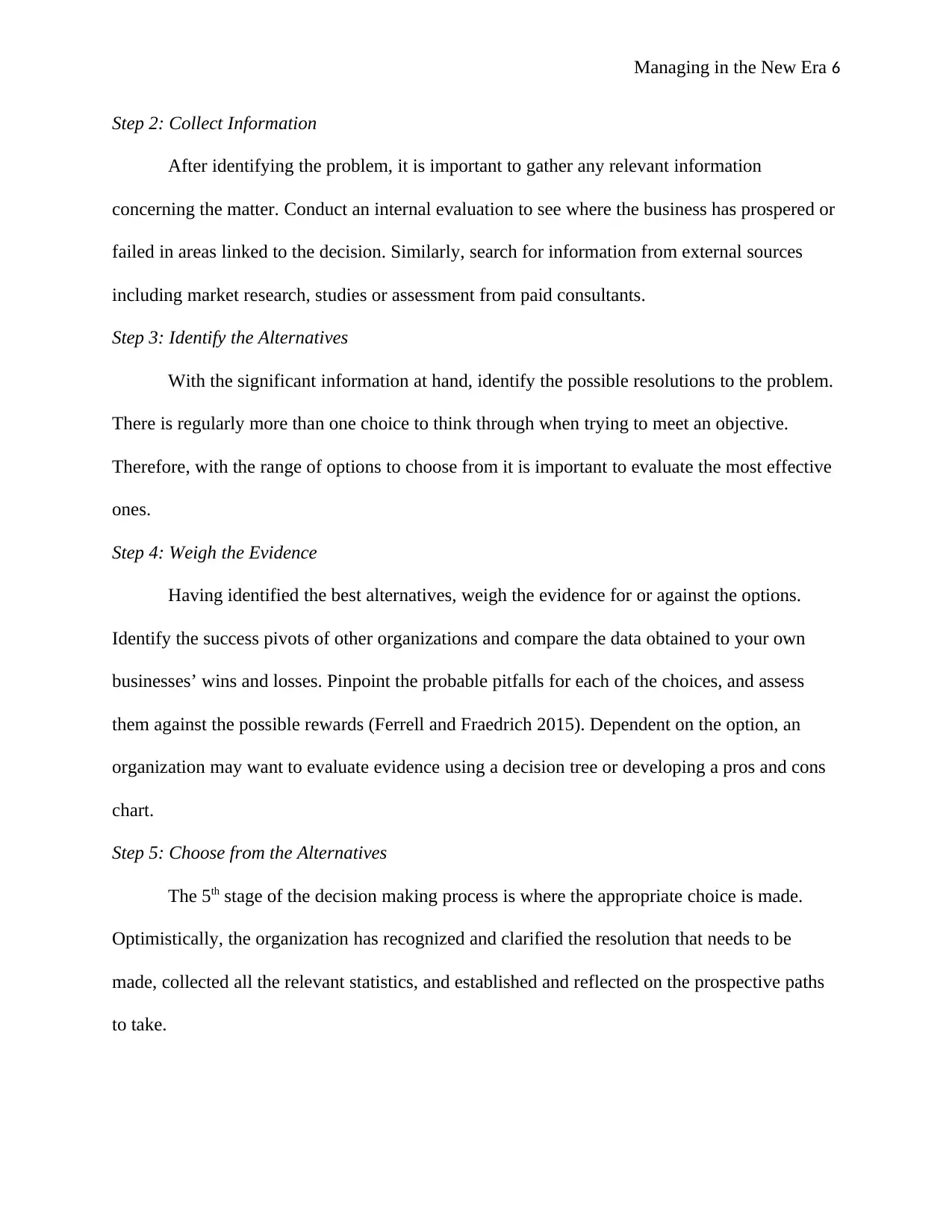
Managing in the New Era 6
Step 2: Collect Information
After identifying the problem, it is important to gather any relevant information
concerning the matter. Conduct an internal evaluation to see where the business has prospered or
failed in areas linked to the decision. Similarly, search for information from external sources
including market research, studies or assessment from paid consultants.
Step 3: Identify the Alternatives
With the significant information at hand, identify the possible resolutions to the problem.
There is regularly more than one choice to think through when trying to meet an objective.
Therefore, with the range of options to choose from it is important to evaluate the most effective
ones.
Step 4: Weigh the Evidence
Having identified the best alternatives, weigh the evidence for or against the options.
Identify the success pivots of other organizations and compare the data obtained to your own
businesses’ wins and losses. Pinpoint the probable pitfalls for each of the choices, and assess
them against the possible rewards (Ferrell and Fraedrich 2015). Dependent on the option, an
organization may want to evaluate evidence using a decision tree or developing a pros and cons
chart.
Step 5: Choose from the Alternatives
The 5th stage of the decision making process is where the appropriate choice is made.
Optimistically, the organization has recognized and clarified the resolution that needs to be
made, collected all the relevant statistics, and established and reflected on the prospective paths
to take.
Step 2: Collect Information
After identifying the problem, it is important to gather any relevant information
concerning the matter. Conduct an internal evaluation to see where the business has prospered or
failed in areas linked to the decision. Similarly, search for information from external sources
including market research, studies or assessment from paid consultants.
Step 3: Identify the Alternatives
With the significant information at hand, identify the possible resolutions to the problem.
There is regularly more than one choice to think through when trying to meet an objective.
Therefore, with the range of options to choose from it is important to evaluate the most effective
ones.
Step 4: Weigh the Evidence
Having identified the best alternatives, weigh the evidence for or against the options.
Identify the success pivots of other organizations and compare the data obtained to your own
businesses’ wins and losses. Pinpoint the probable pitfalls for each of the choices, and assess
them against the possible rewards (Ferrell and Fraedrich 2015). Dependent on the option, an
organization may want to evaluate evidence using a decision tree or developing a pros and cons
chart.
Step 5: Choose from the Alternatives
The 5th stage of the decision making process is where the appropriate choice is made.
Optimistically, the organization has recognized and clarified the resolution that needs to be
made, collected all the relevant statistics, and established and reflected on the prospective paths
to take.
⊘ This is a preview!⊘
Do you want full access?
Subscribe today to unlock all pages.

Trusted by 1+ million students worldwide
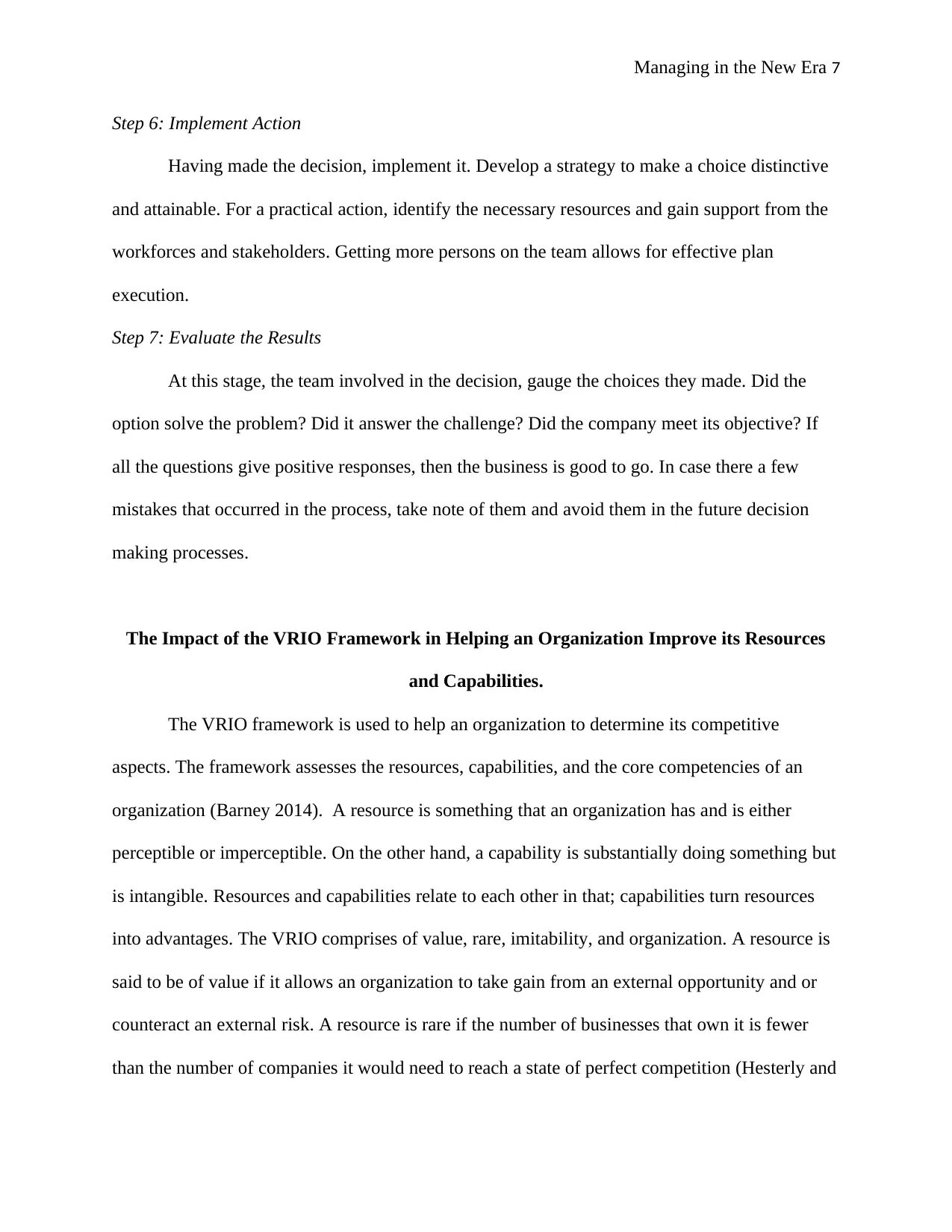
Managing in the New Era 7
Step 6: Implement Action
Having made the decision, implement it. Develop a strategy to make a choice distinctive
and attainable. For a practical action, identify the necessary resources and gain support from the
workforces and stakeholders. Getting more persons on the team allows for effective plan
execution.
Step 7: Evaluate the Results
At this stage, the team involved in the decision, gauge the choices they made. Did the
option solve the problem? Did it answer the challenge? Did the company meet its objective? If
all the questions give positive responses, then the business is good to go. In case there a few
mistakes that occurred in the process, take note of them and avoid them in the future decision
making processes.
The Impact of the VRIO Framework in Helping an Organization Improve its Resources
and Capabilities.
The VRIO framework is used to help an organization to determine its competitive
aspects. The framework assesses the resources, capabilities, and the core competencies of an
organization (Barney 2014). A resource is something that an organization has and is either
perceptible or imperceptible. On the other hand, a capability is substantially doing something but
is intangible. Resources and capabilities relate to each other in that; capabilities turn resources
into advantages. The VRIO comprises of value, rare, imitability, and organization. A resource is
said to be of value if it allows an organization to take gain from an external opportunity and or
counteract an external risk. A resource is rare if the number of businesses that own it is fewer
than the number of companies it would need to reach a state of perfect competition (Hesterly and
Step 6: Implement Action
Having made the decision, implement it. Develop a strategy to make a choice distinctive
and attainable. For a practical action, identify the necessary resources and gain support from the
workforces and stakeholders. Getting more persons on the team allows for effective plan
execution.
Step 7: Evaluate the Results
At this stage, the team involved in the decision, gauge the choices they made. Did the
option solve the problem? Did it answer the challenge? Did the company meet its objective? If
all the questions give positive responses, then the business is good to go. In case there a few
mistakes that occurred in the process, take note of them and avoid them in the future decision
making processes.
The Impact of the VRIO Framework in Helping an Organization Improve its Resources
and Capabilities.
The VRIO framework is used to help an organization to determine its competitive
aspects. The framework assesses the resources, capabilities, and the core competencies of an
organization (Barney 2014). A resource is something that an organization has and is either
perceptible or imperceptible. On the other hand, a capability is substantially doing something but
is intangible. Resources and capabilities relate to each other in that; capabilities turn resources
into advantages. The VRIO comprises of value, rare, imitability, and organization. A resource is
said to be of value if it allows an organization to take gain from an external opportunity and or
counteract an external risk. A resource is rare if the number of businesses that own it is fewer
than the number of companies it would need to reach a state of perfect competition (Hesterly and
Paraphrase This Document
Need a fresh take? Get an instant paraphrase of this document with our AI Paraphraser
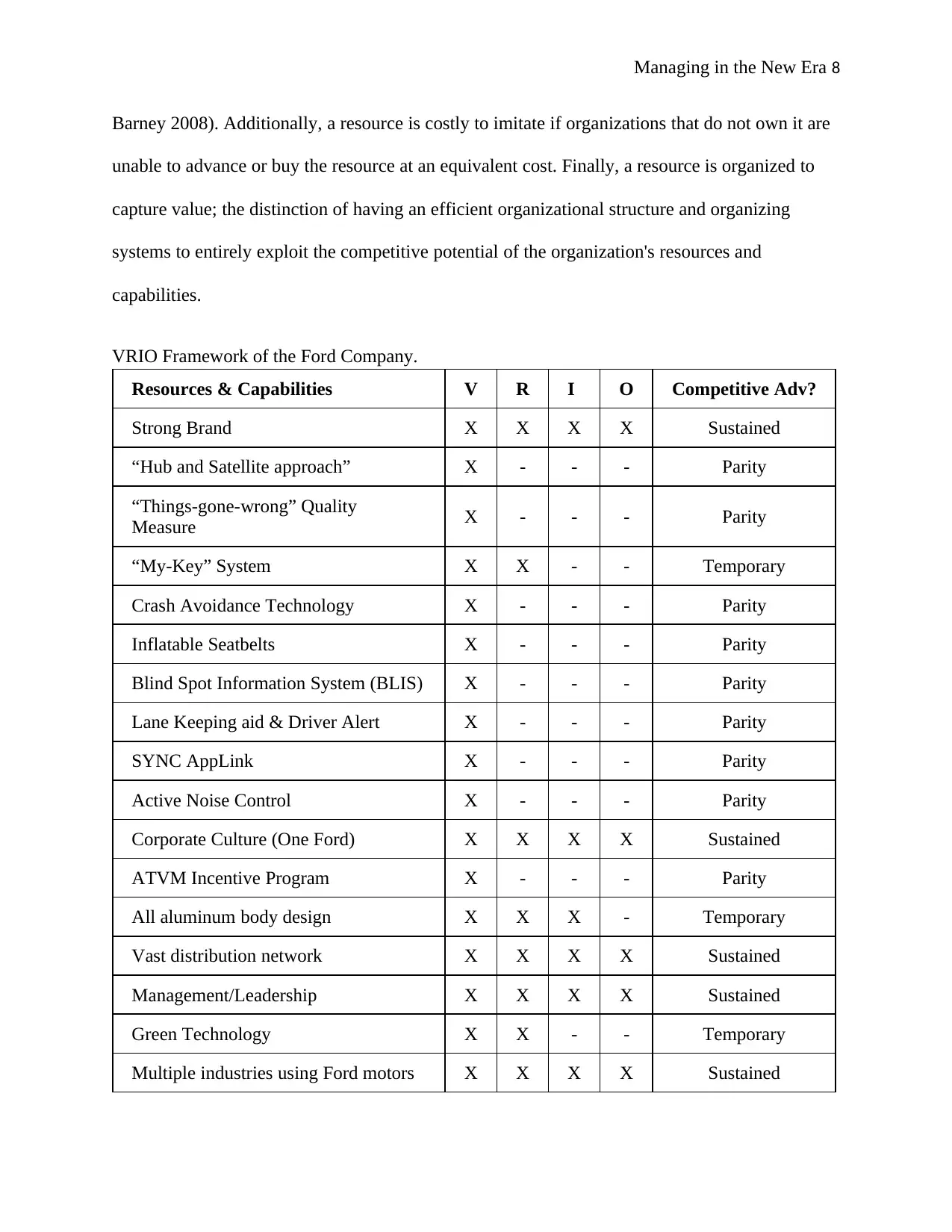
Managing in the New Era 8
Barney 2008). Additionally, a resource is costly to imitate if organizations that do not own it are
unable to advance or buy the resource at an equivalent cost. Finally, a resource is organized to
capture value; the distinction of having an efficient organizational structure and organizing
systems to entirely exploit the competitive potential of the organization's resources and
capabilities.
VRIO Framework of the Ford Company.
Resources & Capabilities V R I O Competitive Adv?
Strong Brand X X X X Sustained
“Hub and Satellite approach” X - - - Parity
“Things-gone-wrong” Quality
Measure X - - - Parity
“My-Key” System X X - - Temporary
Crash Avoidance Technology X - - - Parity
Inflatable Seatbelts X - - - Parity
Blind Spot Information System (BLIS) X - - - Parity
Lane Keeping aid & Driver Alert X - - - Parity
SYNC AppLink X - - - Parity
Active Noise Control X - - - Parity
Corporate Culture (One Ford) X X X X Sustained
ATVM Incentive Program X - - - Parity
All aluminum body design X X X - Temporary
Vast distribution network X X X X Sustained
Management/Leadership X X X X Sustained
Green Technology X X - - Temporary
Multiple industries using Ford motors X X X X Sustained
Barney 2008). Additionally, a resource is costly to imitate if organizations that do not own it are
unable to advance or buy the resource at an equivalent cost. Finally, a resource is organized to
capture value; the distinction of having an efficient organizational structure and organizing
systems to entirely exploit the competitive potential of the organization's resources and
capabilities.
VRIO Framework of the Ford Company.
Resources & Capabilities V R I O Competitive Adv?
Strong Brand X X X X Sustained
“Hub and Satellite approach” X - - - Parity
“Things-gone-wrong” Quality
Measure X - - - Parity
“My-Key” System X X - - Temporary
Crash Avoidance Technology X - - - Parity
Inflatable Seatbelts X - - - Parity
Blind Spot Information System (BLIS) X - - - Parity
Lane Keeping aid & Driver Alert X - - - Parity
SYNC AppLink X - - - Parity
Active Noise Control X - - - Parity
Corporate Culture (One Ford) X X X X Sustained
ATVM Incentive Program X - - - Parity
All aluminum body design X X X - Temporary
Vast distribution network X X X X Sustained
Management/Leadership X X X X Sustained
Green Technology X X - - Temporary
Multiple industries using Ford motors X X X X Sustained
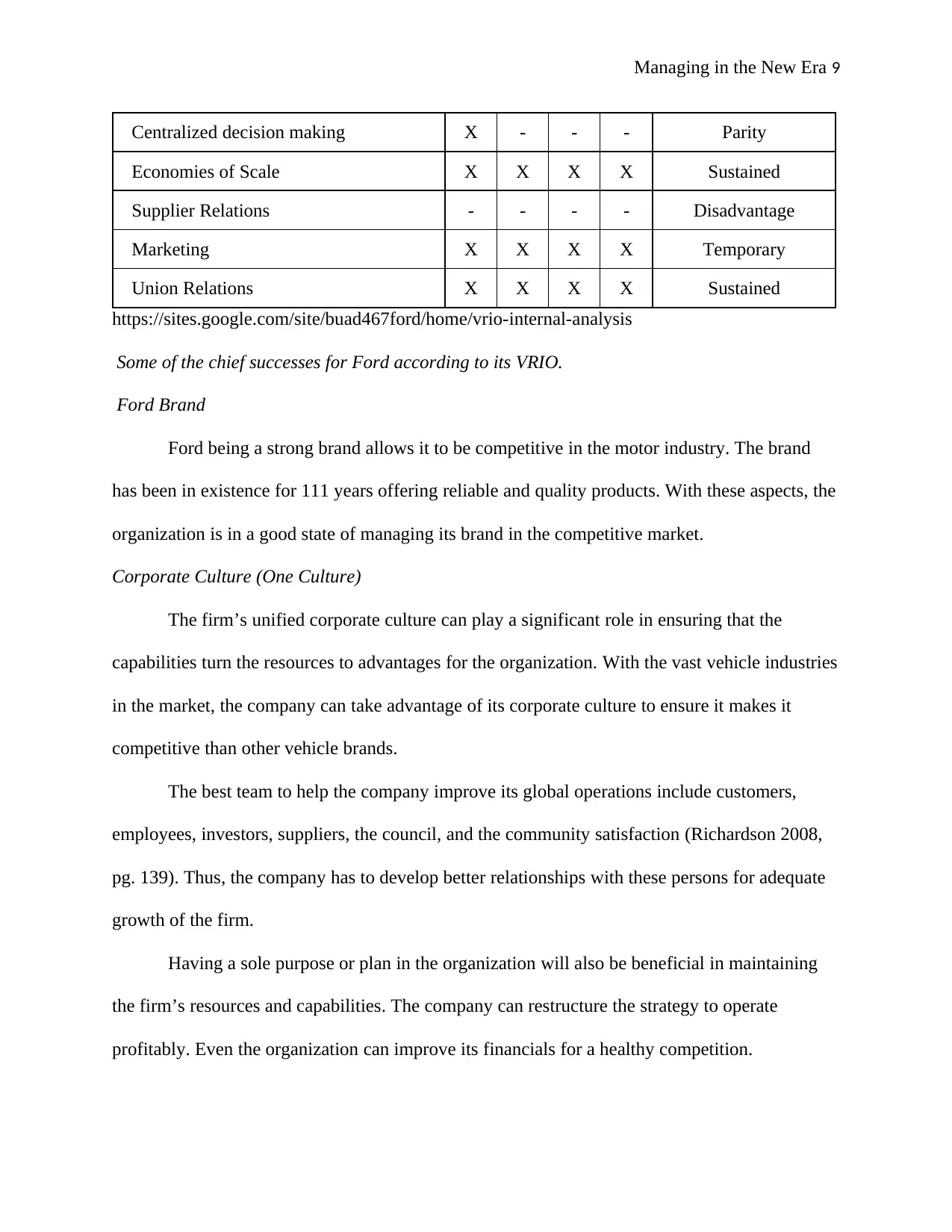
Managing in the New Era 9
Centralized decision making X - - - Parity
Economies of Scale X X X X Sustained
Supplier Relations - - - - Disadvantage
Marketing X X X X Temporary
Union Relations X X X X Sustained
https://sites.google.com/site/buad467ford/home/vrio-internal-analysis
Some of the chief successes for Ford according to its VRIO.
Ford Brand
Ford being a strong brand allows it to be competitive in the motor industry. The brand
has been in existence for 111 years offering reliable and quality products. With these aspects, the
organization is in a good state of managing its brand in the competitive market.
Corporate Culture (One Culture)
The firm’s unified corporate culture can play a significant role in ensuring that the
capabilities turn the resources to advantages for the organization. With the vast vehicle industries
in the market, the company can take advantage of its corporate culture to ensure it makes it
competitive than other vehicle brands.
The best team to help the company improve its global operations include customers,
employees, investors, suppliers, the council, and the community satisfaction (Richardson 2008,
pg. 139). Thus, the company has to develop better relationships with these persons for adequate
growth of the firm.
Having a sole purpose or plan in the organization will also be beneficial in maintaining
the firm’s resources and capabilities. The company can restructure the strategy to operate
profitably. Even the organization can improve its financials for a healthy competition.
Centralized decision making X - - - Parity
Economies of Scale X X X X Sustained
Supplier Relations - - - - Disadvantage
Marketing X X X X Temporary
Union Relations X X X X Sustained
https://sites.google.com/site/buad467ford/home/vrio-internal-analysis
Some of the chief successes for Ford according to its VRIO.
Ford Brand
Ford being a strong brand allows it to be competitive in the motor industry. The brand
has been in existence for 111 years offering reliable and quality products. With these aspects, the
organization is in a good state of managing its brand in the competitive market.
Corporate Culture (One Culture)
The firm’s unified corporate culture can play a significant role in ensuring that the
capabilities turn the resources to advantages for the organization. With the vast vehicle industries
in the market, the company can take advantage of its corporate culture to ensure it makes it
competitive than other vehicle brands.
The best team to help the company improve its global operations include customers,
employees, investors, suppliers, the council, and the community satisfaction (Richardson 2008,
pg. 139). Thus, the company has to develop better relationships with these persons for adequate
growth of the firm.
Having a sole purpose or plan in the organization will also be beneficial in maintaining
the firm’s resources and capabilities. The company can restructure the strategy to operate
profitably. Even the organization can improve its financials for a healthy competition.
⊘ This is a preview!⊘
Do you want full access?
Subscribe today to unlock all pages.

Trusted by 1+ million students worldwide
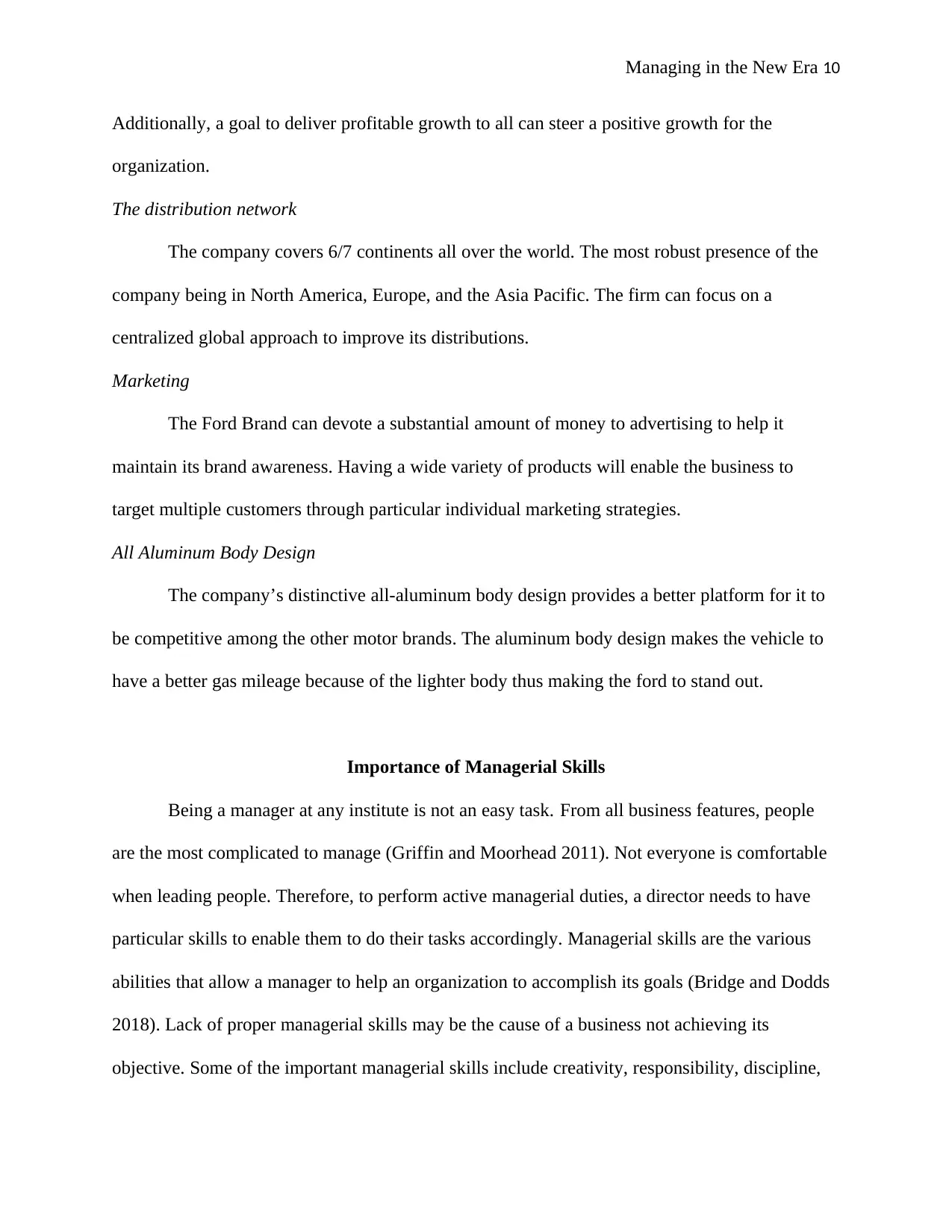
Managing in the New Era 10
Additionally, a goal to deliver profitable growth to all can steer a positive growth for the
organization.
The distribution network
The company covers 6/7 continents all over the world. The most robust presence of the
company being in North America, Europe, and the Asia Pacific. The firm can focus on a
centralized global approach to improve its distributions.
Marketing
The Ford Brand can devote a substantial amount of money to advertising to help it
maintain its brand awareness. Having a wide variety of products will enable the business to
target multiple customers through particular individual marketing strategies.
All Aluminum Body Design
The company’s distinctive all-aluminum body design provides a better platform for it to
be competitive among the other motor brands. The aluminum body design makes the vehicle to
have a better gas mileage because of the lighter body thus making the ford to stand out.
Importance of Managerial Skills
Being a manager at any institute is not an easy task. From all business features, people
are the most complicated to manage (Griffin and Moorhead 2011). Not everyone is comfortable
when leading people. Therefore, to perform active managerial duties, a director needs to have
particular skills to enable them to do their tasks accordingly. Managerial skills are the various
abilities that allow a manager to help an organization to accomplish its goals (Bridge and Dodds
2018). Lack of proper managerial skills may be the cause of a business not achieving its
objective. Some of the important managerial skills include creativity, responsibility, discipline,
Additionally, a goal to deliver profitable growth to all can steer a positive growth for the
organization.
The distribution network
The company covers 6/7 continents all over the world. The most robust presence of the
company being in North America, Europe, and the Asia Pacific. The firm can focus on a
centralized global approach to improve its distributions.
Marketing
The Ford Brand can devote a substantial amount of money to advertising to help it
maintain its brand awareness. Having a wide variety of products will enable the business to
target multiple customers through particular individual marketing strategies.
All Aluminum Body Design
The company’s distinctive all-aluminum body design provides a better platform for it to
be competitive among the other motor brands. The aluminum body design makes the vehicle to
have a better gas mileage because of the lighter body thus making the ford to stand out.
Importance of Managerial Skills
Being a manager at any institute is not an easy task. From all business features, people
are the most complicated to manage (Griffin and Moorhead 2011). Not everyone is comfortable
when leading people. Therefore, to perform active managerial duties, a director needs to have
particular skills to enable them to do their tasks accordingly. Managerial skills are the various
abilities that allow a manager to help an organization to accomplish its goals (Bridge and Dodds
2018). Lack of proper managerial skills may be the cause of a business not achieving its
objective. Some of the important managerial skills include creativity, responsibility, discipline,
Paraphrase This Document
Need a fresh take? Get an instant paraphrase of this document with our AI Paraphraser
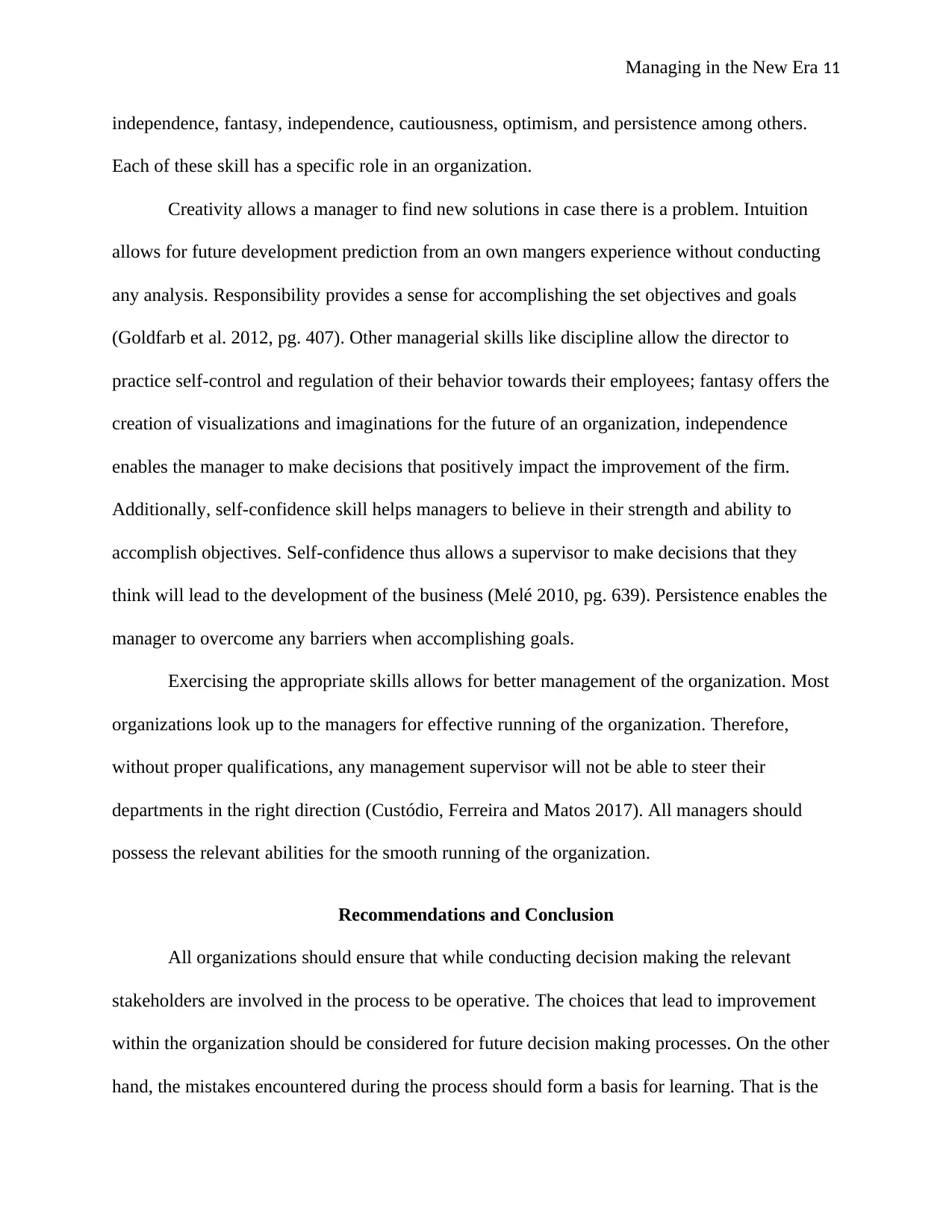
Managing in the New Era 11
independence, fantasy, independence, cautiousness, optimism, and persistence among others.
Each of these skill has a specific role in an organization.
Creativity allows a manager to find new solutions in case there is a problem. Intuition
allows for future development prediction from an own mangers experience without conducting
any analysis. Responsibility provides a sense for accomplishing the set objectives and goals
(Goldfarb et al. 2012, pg. 407). Other managerial skills like discipline allow the director to
practice self-control and regulation of their behavior towards their employees; fantasy offers the
creation of visualizations and imaginations for the future of an organization, independence
enables the manager to make decisions that positively impact the improvement of the firm.
Additionally, self-confidence skill helps managers to believe in their strength and ability to
accomplish objectives. Self-confidence thus allows a supervisor to make decisions that they
think will lead to the development of the business (Melé 2010, pg. 639). Persistence enables the
manager to overcome any barriers when accomplishing goals.
Exercising the appropriate skills allows for better management of the organization. Most
organizations look up to the managers for effective running of the organization. Therefore,
without proper qualifications, any management supervisor will not be able to steer their
departments in the right direction (Custódio, Ferreira and Matos 2017). All managers should
possess the relevant abilities for the smooth running of the organization.
Recommendations and Conclusion
All organizations should ensure that while conducting decision making the relevant
stakeholders are involved in the process to be operative. The choices that lead to improvement
within the organization should be considered for future decision making processes. On the other
hand, the mistakes encountered during the process should form a basis for learning. That is the
independence, fantasy, independence, cautiousness, optimism, and persistence among others.
Each of these skill has a specific role in an organization.
Creativity allows a manager to find new solutions in case there is a problem. Intuition
allows for future development prediction from an own mangers experience without conducting
any analysis. Responsibility provides a sense for accomplishing the set objectives and goals
(Goldfarb et al. 2012, pg. 407). Other managerial skills like discipline allow the director to
practice self-control and regulation of their behavior towards their employees; fantasy offers the
creation of visualizations and imaginations for the future of an organization, independence
enables the manager to make decisions that positively impact the improvement of the firm.
Additionally, self-confidence skill helps managers to believe in their strength and ability to
accomplish objectives. Self-confidence thus allows a supervisor to make decisions that they
think will lead to the development of the business (Melé 2010, pg. 639). Persistence enables the
manager to overcome any barriers when accomplishing goals.
Exercising the appropriate skills allows for better management of the organization. Most
organizations look up to the managers for effective running of the organization. Therefore,
without proper qualifications, any management supervisor will not be able to steer their
departments in the right direction (Custódio, Ferreira and Matos 2017). All managers should
possess the relevant abilities for the smooth running of the organization.
Recommendations and Conclusion
All organizations should ensure that while conducting decision making the relevant
stakeholders are involved in the process to be operative. The choices that lead to improvement
within the organization should be considered for future decision making processes. On the other
hand, the mistakes encountered during the process should form a basis for learning. That is the
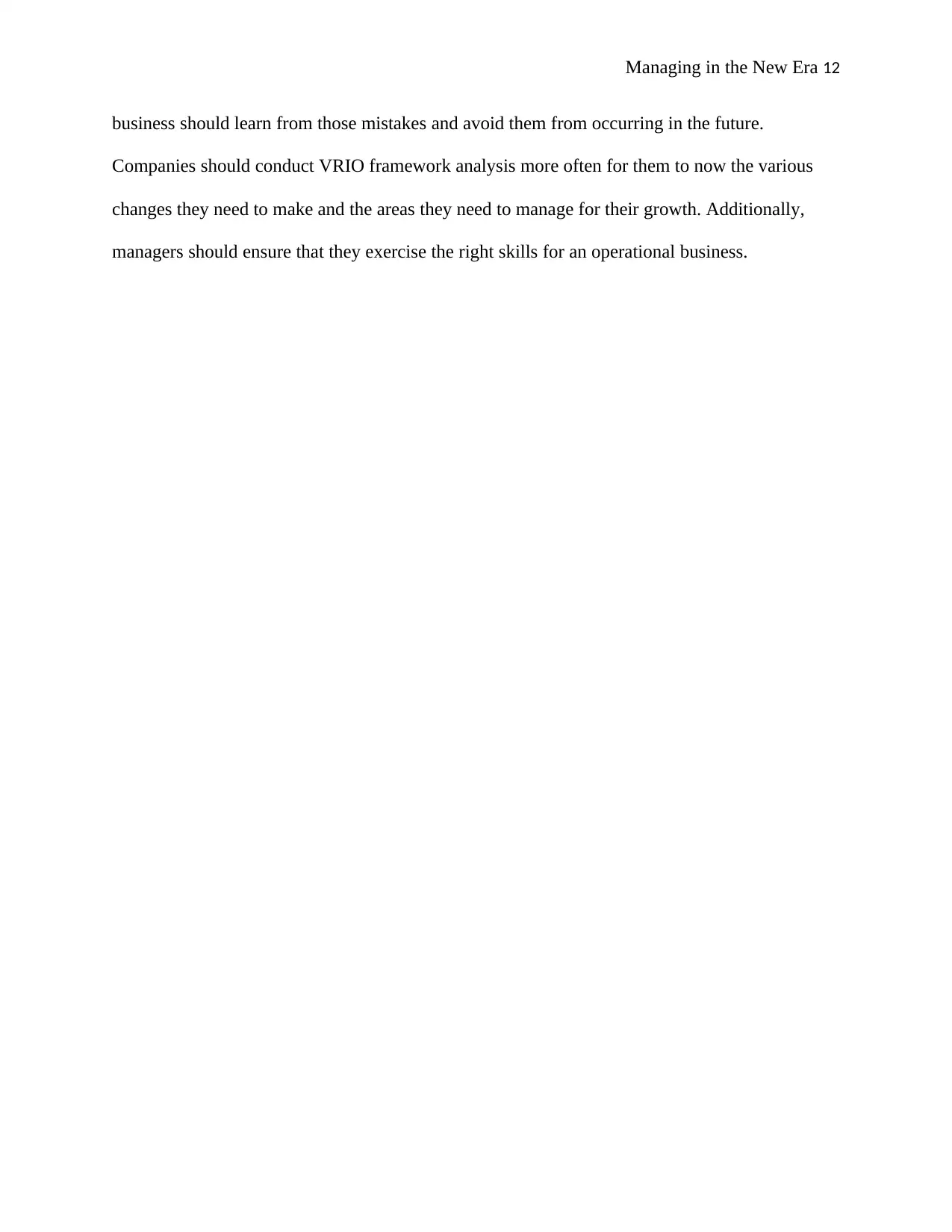
Managing in the New Era 12
business should learn from those mistakes and avoid them from occurring in the future.
Companies should conduct VRIO framework analysis more often for them to now the various
changes they need to make and the areas they need to manage for their growth. Additionally,
managers should ensure that they exercise the right skills for an operational business.
business should learn from those mistakes and avoid them from occurring in the future.
Companies should conduct VRIO framework analysis more often for them to now the various
changes they need to make and the areas they need to manage for their growth. Additionally,
managers should ensure that they exercise the right skills for an operational business.
⊘ This is a preview!⊘
Do you want full access?
Subscribe today to unlock all pages.

Trusted by 1+ million students worldwide
1 out of 14
Related Documents
Your All-in-One AI-Powered Toolkit for Academic Success.
+13062052269
info@desklib.com
Available 24*7 on WhatsApp / Email
![[object Object]](/_next/static/media/star-bottom.7253800d.svg)
Unlock your academic potential
Copyright © 2020–2025 A2Z Services. All Rights Reserved. Developed and managed by ZUCOL.





